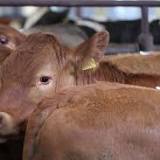This Perfectly Preserved Dinosaur Embryo Shows Link to Modern-Day Birds


A depiction of the dinosaur embryo. Illustration: Julius Csotonyi.
Scientists have discovered an exceptionally preserved dinosaur embryo that has been lying curled inside a fossilized egg for tens of millions of years, offering further evidence of the evolutionary links between dinosaurs and birds.
The 27-centimeter (10.6 inch) embryo, which belonged to a toothless, feathery theropod, or oviraptorosaur, is one of the best preserved dinosaur embryos ever found, according to the study published in iScience on Tuesday.

'Baby Yingliang' is one of the best-preserved dinosaur embryos ever reported. Photo: Xing et al., 2021.
Oviraptorosaurs, which means “egg thief lizards,” are a group of bird-like theropod dinosaurs that lived in what is now Asia and North America during the Late Cretaceous period. They had varied diets, and their sizes ranged from that of a turkey to nearly seven meters in length.
Estimated to have been laid between 72 to 66 million years ago, the egg was found in the Late Cretaceous rocks of Ganzhou in eastern China in 2000, but then kept in storage for about a decade. During the construction of a history museum years later, staff sorted through the fossils and found the embryo inside. It was nicknamed “Baby Yingliang,” after the name of the museum that houses it.
In a pose never seen in non-avian dinosaurs, but similar to those of modern birds, the embryo’s head lies ventral to the body, with the feet on either side, and the back curled along the blunt pole of the egg. Bird embryos attain such postures with a process called “tucking,” which helps stabilize and direct the head when a bird is breaking through the eggshell and is critical to hatching success, according to Fion Ma Wai-sum, a University of Birmingham researcher who worked on the discovery.
The posture of Baby Yingliang looks similar to a roughly 17-day-old “pre-tucking” chicken embryo, Ma wrote in an analysis on The Conversation this week, suggesting tucking could have first evolved among theropod dinosaurs.
“This would add to the body of evidence indicating that many characteristics of modern birds evolved in their dinosaurian ancestors,” she wrote.
The researcher says more detailed analysis should be conducted to compare Baby Yingliang with the embryos of modern birds and crocodiles, the closest living relatives of dinosaurs.
Follow Viola Zhou on Twitter.


 United Kingdom
United Kingdom Argentina
Argentina  Australia
Australia  Austria
Austria  Brazil
Brazil  Canada
Canada  Germany
Germany  Ireland
Ireland  Italy
Italy  Malaysia
Malaysia  Mexico
Mexico  New Zealand
New Zealand  Poland
Poland  South Africa
South Africa  United States
United States 
















